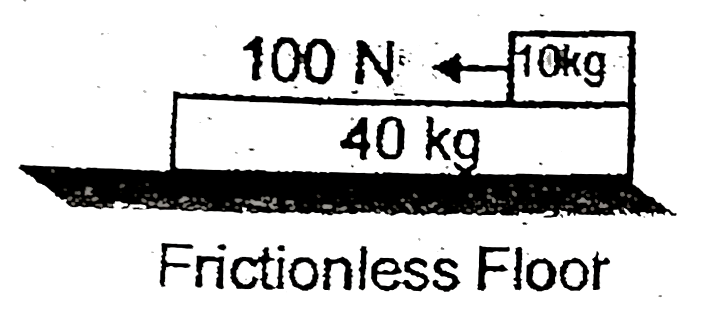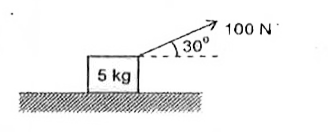The coefficients of static and dynamic friction are 0.7 and 0.4 The minimum force required to create motion is applied on a body and if it is further continued the acceleration attained by the body in ms−2 is (g=10m/s2) .
7
4
3
Zero
The correct Answer is:C
Fnet=ma,FR=fs−fk,a=(μs−μk)g
Topper's Solved these Questions
- BOOK - NARAYNACHAPTER - NEWTONS LAWS OF MOTIONEXERCISE - LEVEL -II (C.W)71videos
NEWTONS LAWS OF MOTION
- BOOK - NARAYNACHAPTER - NEWTONS LAWS OF MOTIONEXERCISE - LEVEL -III31videos
NEWTONS LAWS OF MOTION
- BOOK - NARAYNACHAPTER - NEWTONS LAWS OF MOTIONEXERCISE - C.U.Q73videos
NEWTONS LAWS OF MOTION
- BOOK - NARAYNACHAPTER - MOTION IN A STRAIGHT LINEEXERCISE - Level 2 H.W29videos
MOTION IN A STRAIGHT LINE
- BOOK - NARAYNACHAPTER - OSCILLATIONSEXERCISE - EXERCISE - IV41videos
OSCILLATIONS
Similar Questions
The coefficient of static and dynamic friction between a body and the surface are 0.75 and 0.5 respectively. A force is applied to the body to make it just slide with a constant acceleration which is
View SolutionA 10 N force is applied on a body produces in it an acceleration of 1m/s2. The mass of the body is
View Solution
Knowledge Check
- Question 1 - Select One
A horizontal force just sufficient to move a body of mass 4kg lying on a rought horizontal surface is applied on it .The coefficient of static and kinetic friction the body and the surface are 0.8and0.6 respectively If the force contines to act even after the block has started moving the acceleration of the block in ms−2 is (g=10ms−2)
A1/4B1/2C2D4 - Question 2 - Select One
A horizontal force just sufficient to move a body of mass 4kg lying on a rought horizontal surface is applied on it .The coefficient of static and kinetic friction the body and the surface are 0.8and0.6 respectively If the force contines to act even after the block has started moving the acceleration of the block in ms−2 is (g=10ms−2)
A14B12C2D4 - Question 3 - Select One
A slab of 40kg lying on a frictionales floor and a block of 10 kg rests on the slab as shown in the figure. The coefficients of static and kinetic friction between the slab and the block are 0.6 and 0.4 respectively. If a force of 100N is applied on the block, then the acceleration the slab will be (g=10m/s2)
 A15.5m/s2B155m/s2C1.5m/s2D1m/s2
A15.5m/s2B155m/s2C1.5m/s2D1m/s2
A block of mass 2kg is resting on a rough horizontal surface.The coefficients of static and kinetic frictions between the block and surface are 0.7 and 0.6 respectively.A horizontal force F=(4Ns)×t is applied on the block at t=0.At t=4s ,the force of friction on the block is (take g=10ms2)
View SolutionA 10 N force applied on a body produced in it an acceleration of 1m/s2. The mass of the body is
View SolutionA block of mass 5 kg is placed on a rough horizontal plane. The coefficient of static and kinetic friction between the block and surface is 0.5 and 0.3 respectively. A force of 100 N is applied at an angle of 30∘ from the horizontal as shown in the figure. The acceleration of the block will be [g=10m/s2]
 View Solution
View SolutionA block of mass 2 kg is at rest on a floor . The coefficient of static friction between block and the floor is 0.54. A horizonatl force of 2.8 N is applied to the block . What should be the frictional force between the block and the floor ? ( take , g=10m/s2)
View SolutionThe block of mass 4kg is placed on a rough horizontal surface having the coefficient of kinetic and static friction as 0.4 and 0.5 respectively. If a force of 4N is applied to the body, then the frictional force acting on the body will be [g=ms2]
View Solution

